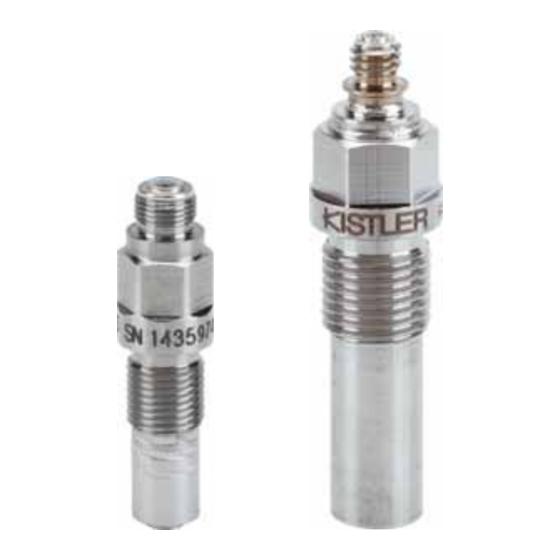
Summarization of Contents
Important Notes
For Your Safety
Notes for personal safety and ensuring long-term, fault-free operation.
Unpacking
Check packaging for transport damage and report to distributor.
Notes on using the Press Force Sensor
Guidelines for using the low level force sensor under specified conditions.
Hints on using these Operating Instructions
Recommendations for reading and using the operating instructions effectively.
General Description
Applications of Low Level Sensors
Overview of applications for low level force sensors, including product testing and research.
Construction and Functional Principle
Details on the construction and operational principle of low level force sensors.
Seal-Tightness
Details on the degree of protection and hermetic sealing of the sensors.
Characteristics of Type 9215A
Details on the 9215A sensor: its size, force introduction, and primary use for compressive forces.
Characteristics of Type 9217A/A1
Details on the 9217A/A1 sensor: a rugged industrial sensor for tensile and compressive forces.
Installation and Startup
Important Installation Notes
Key points regarding the correct use and handling of precision low level force sensors.
Installing Low Level Force Sensors
Guidelines for the correct mounting and installation of low level force sensors.
Adaptation Possibilities
Adaptation A: Force Introduction via Cap
Using a force introducing cap for axial force application.
Adaptation B: Force Introduction via Fixed Connection
Using a fixed screw connection for axial force application.
Adaptation C: Mounting with Coupling Element
Using a coupling element for force introduction to reduce alignment requirements.
Adaptation D: Mounting with Diaphragm
Using a diaphragm for force introduction, which may require recalibration.
Basic Circuitry and Wiring of the Measuring Chain
Overview of the basic circuitry and wiring of the measuring chain.
Notes on Wiring the Measuring Chain
Important considerations and precautions for wiring the measuring chain.
Operation
Setting the Charge Amplifier
Instructions for setting the charge amplifier, including sensitivity and measuring range.
Polarity of the Measuring Signal
Explanation of the polarity of the measuring signal for compressive forces.
Resolution of the Measuring Signal
Definition and factors affecting the resolution of the measuring signal.
Quasistatic Measurements
Information on performing quasistatic measurements and potential drift issues.
Tips for Good Measurands
Practical advice for obtaining accurate and reliable measurement results.
Maintenance
Recalibrating the Instrument
Procedure and recommendation for recalibrating the instrument for accuracy.
Maintenance Work
Essential maintenance tasks to ensure the proper functioning and longevity of the sensor.
Troubleshooting
Fault-Finding and Remedy
Common faults, their causes, and recommended remedies for troubleshooting.
Repairing the Low Level Force Sensor
Information on cases where the low level force sensor cannot be repaired.
Technical Data
Dimensions
Drawings showing the physical dimensions of the sensors.
Sensor Performance Specifications
Key performance data including range, sensitivity, linearity, hysteresis, and environmental factors.
Accessory Information
Details on included, optional, and dimensional data for accessories.
Annex
Glossary
Definitions of technical terms used in the manual.
Measurement Uncertainty
Explanation of systematic and random errors affecting measurement accuracy.
Linearity
Definition and methods for determining linearity and best straight line.
Frequency Range
Information on the useful frequency range and its limitations due to resonance.
Influence of Temperature
Discussion of temperature errors and their impact on sensor measurements.
















Need help?
Do you have a question about the 9217A and is the answer not in the manual?
Questions and answers